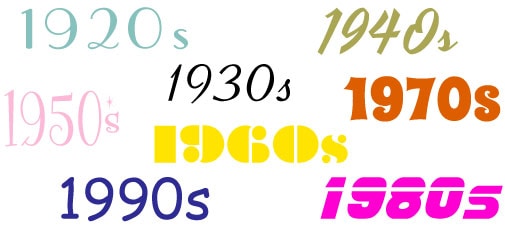
So many of you discussed your love for vintage clothing in the comments section of my previous posts, which made me smile from ear to ear because I love history. I think it’s important to understand how fashion has evolved and why it has changed over the years.
Today I am going to go through the decades, from the 1920s through 1990s, and talk about what was popular in the world of fashion.
In case you are wondering, I got a lot of the fashion information for this post from Nina Garcia’s Little Black Book of Style. It’s a great read and it goes over almost every aspect of what it takes to be a stylish woman. The historical information also partly comes from my spending too many hours watching the history channel or being over-enthused in every history class I’ve ever taken.
Table of Contents
1920s:

Fashion in the 1920s was all about the flapper girls with their drop-waist dresses, boyish silhouettes, and bobbed haircuts. This marked a period of a booming economy and the emergence of women in the workforce in general. Think Daisy in The Great Gatsby. (We’ve done 3 posts on her style: here, here, and here!)
Some of the trends included drop waists, long necklaces, hats, and pastel and muted colors. Where I go for 1920s-inspired pieces is the 1928 jewelry line at Kohl’s.
1930s:

So the 1930s were basically defined by the Great Depression. Men and women needed to work together in order to keep their families afloat, therefore almost undoing the progress that feminists had made in the previous decade.
This return to the classic women was reflected through the return to feminine clothing. The decade was also defined by the emergence of the film industry. This is where the term “Hollywood Glam” originated.
1940s:

In the 1940s, we were involved in World War II. Women were left at home and had to start doing the more masculine tasks, like working in the factories or tending the farm. I always think of the movie A League of their Own, when the women all played baseball while the men were at war, as a great example of what was going on in the ’40s. The Longest Ride also has some great ’40s style inspiration.
So because of this, fashion was transitioning from ultra-feminine looks to something a bit more practical. Military looks became big, but so did the classic hour glass figure. Also, hosiery was very popular. Allie in The Notebook is a perfect example of a movie character who donned 1940s clothing at its finest.
1950s:

In the 1950s, the world began to suburbanize and for the first time, middle class families had a decent amount of spending money due to the economic boom. This in turn made shopping a major leisure activity. Things like costume jewelry, high heels, pencil skirts and glamorous hair and makeup became very popular.
Need a visual? We’ve done a post on ’50s style. Also, take a look at Loraine from Back to the Future when Marty goes back to the 1950s.
1960s:

Ah, sixties mod! While the world was going through major social transitions, short hems and bright clothing took the world by storm. Style, at that time, was meant to make a statement–think go-go boots or wild prints. Colorblocking and cutouts were also huge. Also, the ’60s marked the beginning of ready to wear clothing lines in stores.
When it comes to 1960s clothing, the musical lover in me adores the clothes in Hairspray. Factory Girl is also an amazing reference for the mod look.
1970s:

During the 1970s, social change and protests swept the world, specifically at colleges. People were getting married later in life, women were entering the workforce much more frequently, and the environment became a major issue.
The whole peace and love thing also comes from the early 1970s (as well as the ’60s) and the popular styles reflected that. Things like bell bottom pants, natural fabrics, bohemian style and disco were very popular. Jenny from Forest Gump is a good example of a girl whose clothing represents the time. See also: 4 Ways to Channel the 1970s this Spring.
1980s:

I love the ’80s simply because I am a child of the decade… well at least for three months. Fashion was hit by the Japanese invasion in the 1980s and style reflected that. Off-the-shoulder tops, bright colors, shoulder pads and big hair marked this decade. Think of when Brittany Snow plays Lily on Gossip Girl. Not only does that episode have quality clothing, but also some quality music.
1990s:

Fashion in the 1990s was most defined by the grunge look. The grunge movement was propelled by music, but grunge fashion first appeared on the runway thanks to Marc Jacobs. Also, grunge was a throwback to simpler clothing (in contrast to the excess of the ’80s) and was inspired by the minimalist movement in art. A good example of a ’90s fashionista is Cher from Clueless.
What do You think?
Are you inspired by the decades? Which one is your favorite, and which resonates with your personal style most? What do you think people will one day be writing about the decade we’re in now?

babygirl, you do a pretty terrible job of representing the styles of the decades.